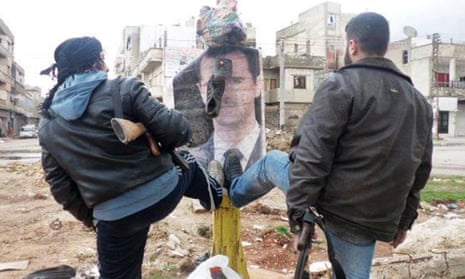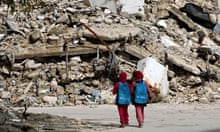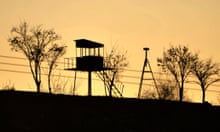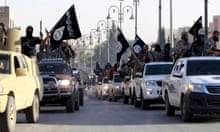No one knows how Syria’s war will end. Four years of violence, destruction and instability have had a terrible impact on millions of its people, on the country and the wider Middle East. But it is already clear that international divisions over the greatest crisis of the 21st century have contributed to its severity and longevity.
Americans, Europeans, Russians, Iranians and Arabs all played their part. Competing interests, misreadings and indecision were on display when the uprising began in March 2011. Western governments were still dazzled by the speed and drama of the early Arab spring. Dictators had been overthrown in Tunisia and Egypt, protests were shaking Bahrain, and Nato was poised to intervene in support of rebels in Libya fighting Muammar Gaddafi.
Initially Hillary Clinton called Bashar al-Assad a “reformer” but then decided he had “lost legitimacy”. In August, Barack Obama fatefully called on Assad to step aside “for the sake of the Syrian people”. Eight years after the US-led invasion of Iraq, that statement meant western support for regime change in another Arab capital.
Britain’s David Cameron, France’s Nicolas Sarkozy and Germany’s Angela Merkel followed suit, demanding Assad “face the reality of the complete rejection of his regime by the Syrian people”.
Russia, a close ally of Syria since Soviet days, took the contrary view – and stuck to it, insisting Assad enjoyed wide support. Russia had been enraged by the way UN approval for humanitarian intervention in Libya had morphed into Nato backing for the anti-Gaddafi uprising. With China – which had also opposed the overthrow of Saddam Hussein – it vetoed a UN resolution condemning Syria. The paralysing cold war-style battle lines that split the UN’s top table have not changed since.
Looking back, it is clear that Assad’s supporters have been more determined all along to keep him in power than his enemies have been to remove him, sending cash, oil, weapons and fighters as well as defending him politically. By the time the US and European positions hardened it was too late. “By then, the Syrian revolutionaries had lost their innocence and the Syrian regime had lost its reticence,” wrote Rime Allaf, a pro-uprising Syrian commentator. “Full-scale military repression was unleashed.”
Alistair Burt, Britain’s Foreign Office minister for the Middle East from 2011 to 2013, observed the difference at close quarters. “The Iranians and Russians and Hezbollah were very clear about what they wanted to do,” he told the Guardian. “But their will and determination was not matched on the western side because we couldn’t work out that this was a battle we needed to win, nor how to do it.”
Turkey lobbied for a no-fly zone and Britain and France drew up contingency plans but worried about Syria’s air defences. There was little public support for another intervention in the Middle East. And western governments believed Syria was different. Unlike in Egypt and Tunisia, the army remained loyal to a notoriously tough regime dominated by rival security agencies. Predicted defections of senior officers did not materialise. Fissures in a majority Sunni country ruled by Alawites and with a substantial Christian minority allowed Assad to manoeuvre while claiming to oppose sectarianism.
And unlike in Libya, there was no clear Arab demand for intervention. Iraq and Algeria backed Assad while Saudi Arabia and Qatar encouraged the flow of money and weapons to rebel units, some linked to the Muslim Brotherhood, others to hardline Salafis. Britain pledged only non-lethal aid and failed in attempts to lift the European Union arms embargo. Eventually the CIA gave discreet small-scale backing to selected armed groups.
But no one in the US, Europe or the Gulf matched the required means to the end of defeating Assad. “In the end western countries weren’t doing much materially but their statements had a powerful impact,” argued Julian Barnes Dacey of the European Council on Foreign Relations. “Iran and Hezbollah quickly came to see Syria as part of a broader regional campaign against them by the Gulf states and the west.”
Burhan Ghalioun, the Paris-based chairman of the opposition Syrian National Council (SNC), set alarm bells ringing when he declared that a post-Assad Syria would end military links with Iran and stop supporting Hezbollah and Hamas, the “axis of resistance”. Tehran responded with its greatest strength – what the analyst Emile Hokayem calls its “strategic patience” – in contrast to the disorganised and squabbling Saudis and Qataris.
Diplomatic efforts to end or contain the war went nowhere slowly. Kofi Annan, the UN’s first Syria envoy, convened the Geneva talks in summer 2012 but Russia and China ensured its communique was ambiguous on the crucial point of whether Assad would have to go before a transition could begin. Later the US joined Britain, France, Turkey and the Gulf states in recognising the revamped opposition National Coalition as “the legitimate representative” of the Syrian people.
The Geneva II conference in January 2014 took place in the shadow of Assad’s chemical weapons attacks the previous August. That was the moment western intervention finally looked likely but failed to materialise despite the breach of Barack Obama’s famous “red lines”. The SNC president, Khaled Khoja, quipped bitterly that they had “turned into a green light to commit more massacres against the Syrian people”. From then on analysts saw a rise in the strength of hardline Islamist groups, who no longer believed that outside powers would act “when Muslims are dying”.
Isis has cast a long shadow over the future of Syria in recent months. In western capitals counter-terrorism efforts have trumped all other aspects of the crisis. Last week the US State Department envoy to the Syrian opposition resigned, apparently out of frustration. Neither defeating the jihadis nor forcing Assad to come to the negotiating table now look like realistic prospects.
Syria’s bloody stalemate thus seems destined to continue indefinitely beyond this anniversary. “The violent grind is just going to go on and on,” one senior Arab policymaker predicted bleakly. “There isn’t much else to say.”











Comments (…)
Sign in or create your Guardian account to join the discussion